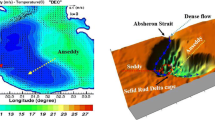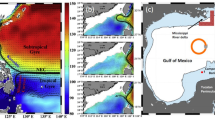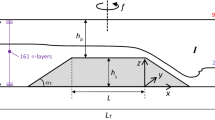Abstract
The Loop Current of the Gulf of Mexico is simulated in the laboratory. A circular tank is filled with water and is placed off-center on a rotating table and the flow field is generated by injecting and withdrawing water at two openings on the wall. The free surface becomes parabolic due to balance of gravitational and centrifugal forces, simulating the latitudinal change of the Coriolis parameter (β-effect) in the ocean. The flow characteristics depend on the influx and the rate of rotation and can be classified according to non-dimensional parameters (Rossby, Ekman and Froude numbers denoted byR 0,E andF, respectively). When the influx is small and the rotation rate is large (smallR 0,E andF) the flow will be almost linear, and the fluid flows along the side-wall boundary layer under constraint of the β-effect. For a very large influx (largeR 0 andE) inertial forces become very large compared to the Coriolis force and the flow behaves like a potential flow. The flow studied had characteristics between these two extreme cases and hasR 0 andF similar to the Gulf circulation, though similarity inE is ambiguous. Photographs of the flow indicate that the inflow penetrates further into the interior when the rotation rate is increased while the influx is kept constant. The numerical analysis of the non-linear vorticity equation confirms this for the parameters corresponding to the experiment. In addition, the photographs reveal eddies embedded on both sides of the main stream, particularly near the inflow region. These eddies are intensified and become uniform in size as the influx increases. It is pointed out that such eddies were actually observed near the Loop Current north of the Yucatan Straits.
Similar content being viewed by others
References
Barcilon, V. (1967),On the motion due to sources and sinks distributed along the vertical boundary of a rotating fluid, J. Fluid Mech.27, 551–561.
Beardsley, R. C. (1975),The ‘sliced-cylinder’ laboratory model of the wind-driven ocean cirulation. Part 2. Oscillatory forcing and Rossby wave resonance, J. Fluid Mech.69, 41–64.
Beardsley, R. C. andRobbins, K. (1975),The ‘sliced-cyclinder’ laboratory model of the wind-driven ocean circulation. Part 1. Steady forcing and topographic Rossby wave instability, J. Fluid Mech.69, 27–40
Cochrane, J. D. (1969),Water and circulation of Campeche Bank in May, Bulletin of the Japanese Society of Fisheries Oceanography, Special number (Prof. Uda's Commemorative Papers). 123–128.
Greenspan, H. P. (1968),The Theory of Rotating Fluids, Cambridge University Press, Cambridge, 106–118, 139–145, 225–233.
Hide, R. (1968),On source-sink flows in a rotating fluid, J. Fluid Mech.32, 737–764.
Ichiye, T. (1962),Circulation and water mass distribution in the Gulf of Mexico. Geofisica Internacional 2(3), 47–76.
Ichiye, T. (1971), The general circulation in the Gulf of Mexico as a two-layer basin. Ref. 71-21-T, Dept. of Oceanography, Texas A&M University. pp. 48.
Ichiye, T. (1972), Experimental circulation modeling within the Gulf and the Caribbean.Contribution on Physical Oceanography of the Gulf of Mexico, edited by L. R. A. Capurro and J. L. Reid. Gulf Publishing Co., Houston, Texas. 213–226.
Imawaki, S. andTakano, K. (1974),Planetary flow in a circular basin, Deep-Sea Res.21, 69–78.
Kuo, H. H., andVeronis, G. (1971),The source-sink flow in a rotating system and its oceanic analogy, J. Fluid Mech.45, 441–464.
Leipper, D. F. (1970),A sequence of current patterns in the Gulf of Mexico, J. Geophys. Res.75, 637–658.
Maul A. G. (1977),The annual cycle of the Gulf Loop Current. Part 1: Observations during a one-year time series, J. Mar. Res.35, 29–47.
Maul, A. G., Norris, D. R. andJohnson, W. R. (1974),Satellite photography of eddies in the Gulf Loop Current, Geophys. Res. Letters1, 256–257.
Niiler, P. P. andRichardson, W. S. (1973),Seasonal variability of the Florida Current, J. Mar. Res.31, 144–167.
Parker, C. E. (1971),Gulf Stream rings in the Sargasso Sea, Deep-Sea Res.18, 981–993.
Paskausky, D. F. andReid, R. O. (1972), A barotropic prognostic numerical circulation model.Contribution on Physical Oceanography of the Gulf of Mexico, edited by L. R. A. Capurro and J. L. Reid, Gulf Publishing Co., Houston, Texas. 177–209.
Reid, R. O. (1972), A simple dynamic model of the Loop Current.Contribution on Physical Oceanography of the Gulf of Mexico, edited by L. R. A. Capurro and J. L. Reid, Gulf Publishing Co., Houston, Texas. 157–159.
Stommel, H., Arons, A. B. andFaller, A. J. (1958),Some examples of stationary planetary flows, Tellus10, 179–187.
Stumpf, H. G. andRao, P. K. (1975)Evolution of Gulf Stream as seen in satellite infrared imagery, J. Phys. Oceanog.5, 388–393.
Author information
Authors and Affiliations
Rights and permissions
About this article
Cite this article
Kuo, HH., Ichiye, T. Inflow and outflow in a rotating circular container—A laboratory model for the Loop Current of the Gulf of Mexico. PAGEOPH 117, 943–957 (1979). https://doi.org/10.1007/BF00876078
Received:
Issue Date:
DOI: https://doi.org/10.1007/BF00876078




